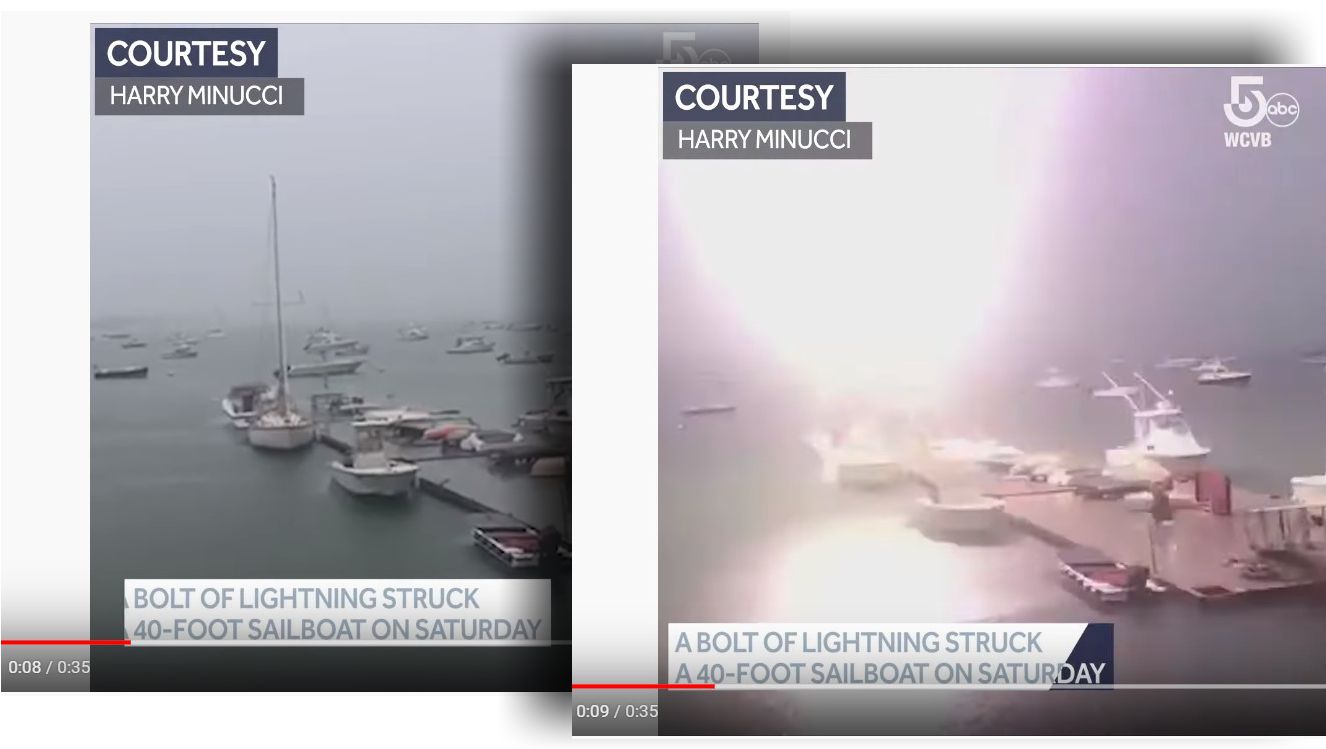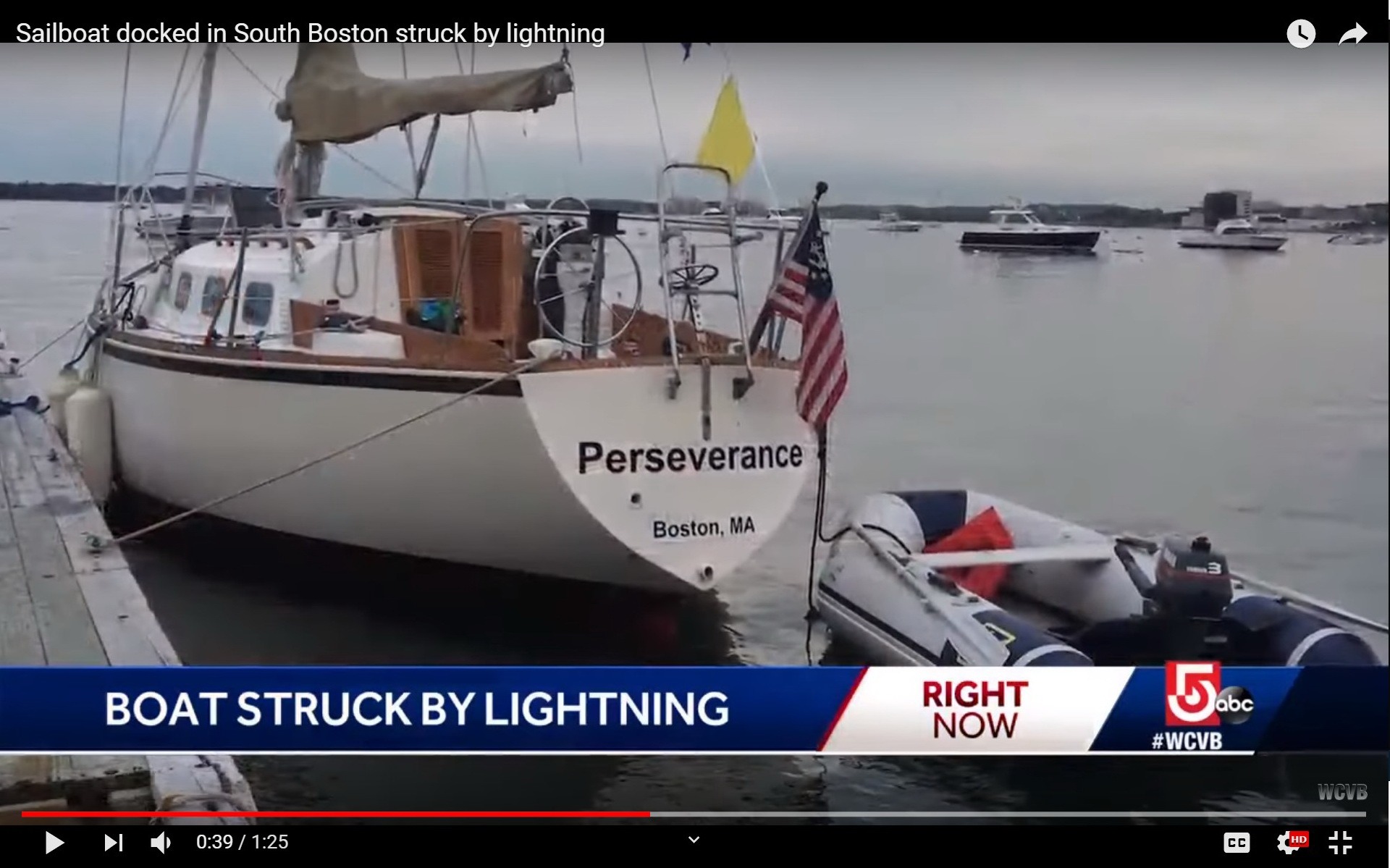Lightning strikes, nicely refit 1978 Bristol 29.9 dies

We know how dangerous lightning can be to a boat and its crew, but to see it actually strike is something else. After a multi-year DIY refit, the 1978 Bristol 29.9 Perseverance lays at a Dorchester float completely ready for a challenging offshore race, but one second later she’s damaged beyond repair. Fortunately, the owner was not on board, and now he and the CCA have made the lightning damage details available to all of us who should be aware of how perverse and pervasive they can be.

WCVB Channel 5 Boston’s video includes much of Harry Minucci’s original phone video along with an interview of owner/operator Drew Plominski. The timing of the lightning strike certainly could have been worse, but what a finish to so much hard work (with asinine YouTuber comments adding salt to the wound).
Trying to forget “a constructive total loss” like this may have been tempting, so extra credit to Plominski for writing a full report on the incident and allowing the Cruising Club of America to make it public. Download Lightning Strike on Perseverance PDF here. Also note CCA’s revised Safety for Cruising Couples.















Mr. Plominski is certainly to be commended for his willingness to share the details of his tragedy!
I spent my career building lightning protection into radio communication sites – building tops and mountaintops, not boats – but the damage here looks awfully familiar. Lightning enters thru the elevated conductor (a tower with antennas on a site, the mast on a sailboat) then, lacking a good path to ground, exits at whatever points it can find to get to ground. Current (an IEEE standard lightning bolt is 20,000 amps, but they vary widely) flows along whatever conductors it finds (metal mast, metal rigging, radio coax) then jumps along a path that takes it toward ground – in the case of a boat, the sea.
The “trick” in protecting oneself from lightning damage is to provide paths for that current that doesn’t include stuff like your electronics, hull, prop & shaft!
No, those “lightning suppressors” that look like metal brushes stuck up in the air don’t work – people selling those things worked their way through the radio business back in the 80’s and lots of folks tried them – but the end result was conclusive – while the bonding system that was generally installed along with them helped a lot, the brushes themselves were useless.
Percentage-wise, unless you sail in certain high-lightning areas (Tampa Bay, Florida, for example) the odds are pretty good you won’t be hit – Boston Harbor would seem to be a pretty low-risk area, but sometimes the odds fail 🙁
To my knowledge, no boat comes with a lightning bonding system installed, it’s something you have to add yourself – would a mast grounding electrode, chainplate bonding and electrical system surge suppression have saved Perseverance? I don’t know, but it sure wouldn’t have hurt!
Thanks, Hartley! Note the old article I posted below, which confirms some of your thoughts. But then again, did you ever see a “Streamer Inhibiting Electrode” like the one on Gizmo?
https://panbo.com/gizmos-halo-hello-lightning-electrotechnologies/
Lightning Electrotechnologies didn’t make it in the boat world, but are apparently doing well with cell tower protection:
https://lightningelectro.com/products-and-technology/streamer-inhibiting-electrodes-and-conductors/
Meanwhile, I don’t dare to take down the sample they made for Gizmo, seems like asking for trouble 😉
Looks like snake oil to me, Ben. I seem to remember discussing that thing with you when we met the first time in Camden Harbor 🙂
There is nothing wrong with posting an grounded electrode above your antennas/roofline – heck, even Tesla (the inventor, not the car manufacturer) recommended one. The lightning hits it instead of your fragile “stuff”. Cell towers, in particular, can benefit from a lightning electrode at the top, since their antennas are generally side-mounted (as in the photo they included.
And having a nice, big cable from it to whatever your local ground is makes the biggest difference – you are diverting most of the energy along that conductor instead of thru your equipment, cabling, etc. With guyed towers (sounds like a sailboat, huh?) a great deal can be gained by grounding the guy wires at the anchor point since the guy wires share the current with the tower itself.
There’s a 10 gauge stranded copper cable running from the stainless base of the “inhibitor” to an 8-inch Dynaplate on the hull, which was how the old “brush” inhibitor was grounded.
Frankly, I’d like to get rid of the inhibitor altogether (or a least stop trying to keep VHF antennas within its cone). It would be easy to leave the big aluminum plate at the top of the mast grounded.
Also, I don’t intend to take Gizmo to Florida, so your advice on this may never be tested 😉
I was inspired to resurrect an article I wrote about lightning in 2003 for PMY. Nothing much has changed as far as I know, and note how expert Ewen Thompson explained to me that the danger on powerboats is arguably greater:
http://panbo.com/wp-content/uploads/2020/02/ZapBoom-BenE-PMY2003.pdf
Nothing really mysterious about lightning, other than some of the little details that turn up after the event (why did it do THAT?) – the science of lightning protection is pretty mature these days – radio sites that get hit dozens (or more) times a year are seldom seriously damaged anymore, for instance. (Antennas themselves are sometimes damaged, but thats the extent of it).
The principle is to facilitate & divert the lightning energy into conductors and a ground system that is appropriate to the job – towers and guy wires are connected to ground with heavy conductors, every conductor entering the shelter (particularly those entering from the tower, but others as well) is grounded if possible (generally shielding conductors) at the entrance point and other leads pass through arrestor devices appropriate to the system (RF, data, telephone, power, etc.) at the same point. Particularly sensitive equipment might have additional suppressors installed.
I bet Bill Bishop would agree with me that more equipment is damaged on boats thru “nearby” strikes then by direct hits – the sailboat in an adjacent slip gets hit, and everyone nearby has their battery charger and AC appliances destroyed. This is where “every conductor entering” has meaning – protect your AC inlet with a serious surge arrestor (and test your galvanic isolator if you think there might have been a nearby strike! – thanks for that tip, Rod!) and also your telephone or cable TV inlet if you have them.
Maybe I should actually write that article your wanted me to do back when :).
As I’m writing this, there is a front bearing down on Riviera Beach, with a forecast of 60% chance of thunderstorms tonight – seems appropriate, somehow =8^O
I have a Bristol 29.9 that does have some lightning protection installed. I would be very interested in speaking with Ben, or other knowledagle person, regarding the system and whether it might prevent some of the damage Drew Plominski experienced.
Before our purchase of Rozinante in 2009 she was hit by lightning while sitting on a ball. A number of people on shore saw it happen, called owner, together with much help from Marina she was on trailer out of water in three hours and had water up to the floor boards.
Insurance company sold to friend that repaired 50+ pin holes under waterline and one through hole the size of a tennis ball. Replaced all the raymarine equipment rewired everything. Cannot speak to any other areas that could have been discolored. There was no sacrificial metal on exterior. Don’t know if there was any other lightning protection. Unlikely.